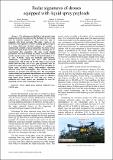Files in this item
Radar signatures of drones equipped with liquid spray payloads
Item metadata
| dc.contributor.author | Rahman, Samiur | |
| dc.contributor.author | Robertson, Duncan A. | |
| dc.contributor.author | Govoni, Mark | |
| dc.date.accessioned | 2021-02-23T15:30:11Z | |
| dc.date.available | 2021-02-23T15:30:11Z | |
| dc.date.issued | 2020-12-04 | |
| dc.identifier | 269081102 | |
| dc.identifier | e42d54e3-ad19-4c4b-9aab-917902f28c8f | |
| dc.identifier | 000612224900066 | |
| dc.identifier | 85098573168 | |
| dc.identifier.citation | Rahman , S , Robertson , D A & Govoni , M 2020 , Radar signatures of drones equipped with liquid spray payloads . in 2020 IEEE Radar Conference (RadarConf20) . , 9266374 , Proceedings of the IEEE National Radar Conference , IEEE , 2020 IEEE Radar Conference (RadarConf) , Florence , Italy , 21/09/20 . https://doi.org/10.1109/RadarConf2043947.2020.9266374 | en |
| dc.identifier.citation | conference | en |
| dc.identifier.isbn | 9781728189437 | |
| dc.identifier.isbn | 9781728189420 | |
| dc.identifier.issn | 2375-5318 | |
| dc.identifier.other | ORCID: /0000-0002-5477-4218/work/89628192 | |
| dc.identifier.other | ORCID: /0000-0002-4042-2772/work/89628324 | |
| dc.identifier.uri | https://hdl.handle.net/10023/21490 | |
| dc.description | Funding: Army Research Laboratory under Cooperative Agreement Number: W911NF-19-2-0075. | en |
| dc.description.abstract | The widespread availability of cheap and robust commercial drones has increased the likelihood of these being used for malicious purposes. In some cases they may be equipped with threat payloads. This study reports on the distinctive radar signatures of drones spraying liquid, analogous to a drone delivering chemical weapons, for example. A commercially available crop spraying drone has been used as the basis for liquid droplet radar backscatter modelling and for experimental data acquisition. The spray nozzle droplet parameters were used to model the radar cross section (RCS) and the signal-to-noise ratio (SNR) of the liquid droplets at X-, K- and W-bands, using the Rayleigh approximation. Additionally, experimental data have been obtained simultaneously with 24 GHz and 94 GHz radars. The processed results show that they are in very good agreement with the model. It is clearly demonstrated that at W-band (94 GHz), the liquid spray produces strong micro-Doppler signatures observed from the range-Doppler plots whereas no such detection was possible at K-band (24 GHz). The experimental results validate the hypothesis that millimeter-wave radar offers superior sensitivity than lower frequency bands to reflections from liquid spray droplets of <<0.5 mm size. Hence, a millimeter-wave radar system can potentially be used for classifying a drone with a liquid spray payload. | |
| dc.format.extent | 5 | |
| dc.format.extent | 968224 | |
| dc.language.iso | eng | |
| dc.publisher | IEEE | |
| dc.relation.ispartof | 2020 IEEE Radar Conference (RadarConf20) | en |
| dc.relation.ispartofseries | Proceedings of the IEEE National Radar Conference | en |
| dc.subject | Drone | en |
| dc.subject | Liquid Spray | en |
| dc.subject | Payload | en |
| dc.subject | Millimeter wave | en |
| dc.subject | FMCW radar | en |
| dc.subject | QC Physics | en |
| dc.subject | T Technology | en |
| dc.subject | U Military Science | en |
| dc.subject | DAS | en |
| dc.subject.lcc | QC | en |
| dc.subject.lcc | T | en |
| dc.subject.lcc | U | en |
| dc.title | Radar signatures of drones equipped with liquid spray payloads | en |
| dc.type | Conference item | en |
| dc.contributor.institution | University of St Andrews. School of Physics and Astronomy | en |
| dc.identifier.doi | 10.1109/RadarConf2043947.2020.9266374 | |
| dc.date.embargoedUntil | 2020-12-04 |
This item appears in the following Collection(s)
Items in the St Andrews Research Repository are protected by copyright, with all rights reserved, unless otherwise indicated.

